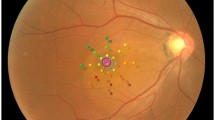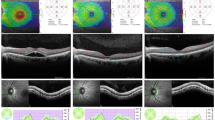Abstract
Purpose
To predict changes in retinal sensitivity using optical coherence tomography (OCT) in eyes with central serous chorioretinopathy (CSC).
Methods
Twenty-three eyes in 23 patients with CSC were enrolled. Retinal sensitivity was measured twice using microperimetry in all the examined eyes. Spectral domain OCT measurements were simultaneously conducted. The relationship between retinal sensitivity and the thicknesses of (i) the retinal nerve fiber layer plus the ganglion cell layer (RNFL + GCL), (ii) the inner nuclear layer (INL), (iii) the outer nuclear layer (ONL), and (iv) the serous retinal detachment height (SRDH) were investigated in a point-wise manner. The associations between the change in retinal sensitivity and the OCT parameters at baseline were also investigated.
Results
The mean age of the participants was 49.8 ± 10.7 years. The mean SRDH was significantly lower (p < 0.001), and the mean retinal sensitivity (p < 0.001) was significantly higher at the second examination, compared with the first; however, the logMAR visual acuity (VA) did not differ significantly between the two examinations (p = 0.063). The logMAR VA was associated with retinal sensitivity at both the first and second examinations (p < 0.001). The retinal sensitivity at the second examination was significantly correlated with the retinal sensitivity, RNFL + GCL, INL, ONL, and SRDH at the first examination and with the improvement in SRDH.
Conclusions
Retinal sensitivity was associated with the retinal structure in eyes with CSC; these parameters could be useful for predicting the change in visual function prior to treatment.

Similar content being viewed by others
Data availability
None.
References
Daruich A, Matet A, Dirani A et al (2015) Central serous chorioretinopathy: RECENT findings and new physiopathology hypothesis. Prog Retin Eye Res 48:82–118
Ojima Y, Hangai M, Sasahara M et al (2007) Tree-dimensional imaging of the foveal photoreceptor layer in central serous chorioretinopathy using high-speed optical coherence tomography. Ophthalmology 114:2197–2207
Vogel RN, Langlo CS, Scoles D, Carroll J, Weinberg DV, Kim JE (2017) High-resolution imaging of intraretinal structures in active and resolved central serous chorioretinopathy. Invest Ophthalmol Vis Sci 58:42–49
Sekine A, Imasawa M, Iijima H (2010) Retinal thickness and perimetric sensitivity in central serous chorioretinopathy. Jpn J Ophthalmol 54(6):578–583
Eandi CM, Piccolino FC, Alovisi C et al (2015) Correlation between fundus autofluorescence and central visual function in chronic central serous chorioretinopathy. Am J Ophthalmol 159:652–658
Baran NV, Gurlu VP, Esgin H (2005) Long-term macular function in eyes with central serous chorioretinopathy. Clin Exp Ophthalmol 33:369–372
Ozdemir H, Karacorlu SA, Senturk F, Karacorlu M, Uysal O (2008) Assessment of macular function by microperimetry in unilateral resolved central serous chorioretinopathy. Eye (Lond) 22:204–208
Ehrlich R, Mawer NP, Mody CH, Brand CS, Squirrell D (2012) Visual function following photodynamic therapy for central serous chorioretinopathy: a comparison of automated macular microperimetry versus best-corrected visual acuity. Clin Exp Ophthalmol 40:e32-39
Reibaldi M, Boscia F, Avitabile T et al (2011) Functional retinal changes measured by microperimetry in standard-fluence vs low-fluence photodynamic therapy in chronic central serous chorioretinopathy. Am J Ophthalmol 151(953–960):e2
Ojima Y, Tsujikawa A, Hangai M et al (2008) Retinal sensitivity measured with the micro perimeter 1 after resolution of central serous chorioretinopathy. Am J Ophthalmol 146:77–84
Chung HW, Yun CM, Kim JT et al (2014) Retinal sensitivity assessed by microperimetry and corresponding retinal structure and thickness in resolved central serous chorioretinopathy. Eye (Lond) 28:1223–1230
Sugiura A, Fujino R, Takemiya N et al (2017) The association between visual function and retinal structure in chronic central serous chorioretinopathy. Sci Rep 7:16288
Matsuura M, Murata H, Fujino Y, Hirasawa K, Yanagisawa M, Asaoka R (2018) Evaluating the usefulness of MP-3 microperimetry in glaucoma patients. Am J Ophthalmol 187:1–9
Asahina Y, Kitano M, Hashimoto Y et al (2017) The structure-function relationship measured with optical coherence tomography and a microperimeter with autotracking: the MP-3, in patients with retinitis pigmentosa. Sci Rep 7:15766
Fujino R, Asaoka R, Aoki S et al (2020) The usefulness of the retinal sensitivity measurement with a microperimetry for predicting the visual prognosis of branch retinal vein occlusion with macular edema. Graefes Arch Clin Exp Ophthalmol 258(9):1949–1958
Lee J, Asano S, Inoue T et al (2018) Investigating the usefulness of fundus autofluorescence in retinitis pigmentosa. Ophthalmol Retina 2(10):1062–1070
Igarashi N, Matsuura M, Hashimoto Y et al (2016) Assessing visual fields in patients with retinitis pigmentosa using a novel microperimeter with eye tracking: the MP-3. PLoS One 11:e0166666
Burnham KP, Anderson DR (2004) Multimodel inference: understanding: AIC and BIC in model selection. Sociol Methods Res 33:261–304
Nakagawa S, Schielzeth H (2013) A general and simple method for obtaining R2 from generalized linear mixed-effects models. Methods Ecol Evol 4(2):133–142
Fujita A, Aoyama Y, Tsuneyoshi S et al (2019) Association between visual function and the integrity of residual ellipsoid zone in resolved central serous chorioretinopathy. Sci Rep 9:12433
Kim SK, Kim SW, Oh J, Huh K (2013) Near-infrared and short wavelength autofluorescence in resolved serous chorioretinopathy: association with outer retinal layer abnormalities. Am J Ophthalmol 156(1):157–164
Soga H, Asaoka R, Kadonosono K et al (2021) Association of near-infrared and short-wavelength autofluorescence with the retinal sensitivity in eyes with resolved central serous chorioretinopathy. Invest Ophthalmol Vis Sci 62(3):36
Author information
Authors and Affiliations
Contributions
SK and TI were responsible for writing the protocol and report, conducting the search, screening potentially eligible studies, extracting and analyzing data, interpreting results, updating reference lists and creating the “Summary of findings” tables. HZ, RF, AS, YA, KK, MM, RO, and RA provided feedback on the report. All the authors have read and approved the manuscript.
Corresponding authors
Ethics declarations
Ethics approval and consent to participate
This study was approved by the Research Ethics Committee of the Graduate School of Medicine and Faculty of Medicine at The University of Tokyo. The committee’s reference number is 2217.
Consent for publication
Done.
Competing interests
The authors declare no competing interests.
Additional information
Publisher's note
Springer Nature remains neutral with regard to jurisdictional claims in published maps and institutional affiliations.
Rights and permissions
About this article
Cite this article
Kanda, S., Zhou, H.P., Inoue, T. et al. Predicting retinal sensitivity using optical coherence tomography parameters in central serous chorioretinopathy. Graefes Arch Clin Exp Ophthalmol 260, 3499–3504 (2022). https://doi.org/10.1007/s00417-022-05717-3
Received:
Revised:
Accepted:
Published:
Issue Date:
DOI: https://doi.org/10.1007/s00417-022-05717-3




